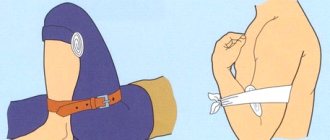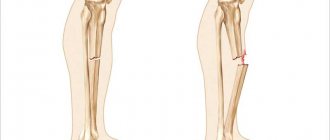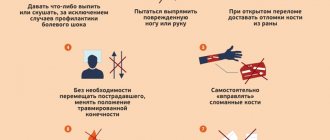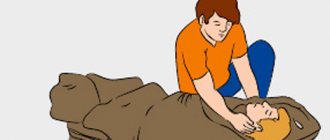Loss of blood is a very dangerous phenomenon that can lead to death in a short time. Without the timely provision of specialized care, the chances of survival with major blood loss are lost every minute. This necessitates the need to have basic first aid skills that can save a person. In this article we will pay attention to venous bleeding, its features, and first aid techniques.
Stopping venous bleeding is one of the most important first aid skills, as damage to large vessels can lead to massive blood loss and death in a matter of minutes.
Specifics and signs of venous bleeding
Specifics and signs of venous bleeding
Veins are a network of vessels that move blood from internal organs to the heart muscle.
Signs of bleeding that occurs due to mechanical damage to the veins are: - dark - brown color of blood (unsaturated with oxygen, unlike cases of arterial bleeding) - smooth, non-pulsating flow - pallor and lethargy of the injured person Venous bleeding can be determined by pressing on the vein near the bleeding wound - with venous bleeding, blood loss will be sharply reduced. Depending on the location of the wound, the nature of first aid varies somewhat, therefore, having identified the source of bleeding, it is necessary to quickly implement an algorithm for providing assistance. Basic rules for providing first aid step by step, ways to stop
Types of bleeding
The type of bleeding depends on which vessel is damaged, in which part of the body it is localized, and the intensity of blood loss.
Classification according to the type of damage to blood vessels:
- capillary bleeding;
- venous;
- internal (parenchymal);
- arterial;
- mixed bleeding.
Classification according to the cause of bleeding:
- abnormal bleeding;
- traumatic.
Classification according to the location of blood loss:
- external;
- internal.
Classification by volume of blood loss:
On average, about 5 liters of blood circulates in the body of an adult. Depending on the volume of fluid spilled, doctors distinguish the following degrees of blood loss:
- mild degree (less than 0.5 liters);
- medium (less than 1 liter);
- heavy (about 1.5 liters);
- massive (about 2.5 liters);
- lethal (about 3 liters), i.e. more than half of the total blood volume;
- absolutely lethal (more than 3.5 liters), i.e. above 60%.
First aid for bleeding is a system of therapeutic and preventive measures that must be taken in case of damage to blood vessels (arteries, capillaries and veins) until qualified medical assistance becomes available. Each type of bleeding has its own characteristics in providing assistance.
Basic rules for providing first aid step by step, ways to stop
Generally accepted actions when venous bleeding is detected are as follows:
- The sections of the vein above and below the injury site must be clamped as close to the bone as possible. To clamp the vein, a tourniquet, thick fabric and similar improvised means are used; in the absence of means, clamping is done with the fingers.
- The wound must be covered with cotton wool or a piece of fabric - this will prevent air bubbles from entering the vein and prevent further development of air embolism.
- If possible, it is necessary to apply ice or any cold object to the wound site that helps slow down the flow of blood circulation.
- Calling an ambulance or any action to hospitalize the victim as quickly as possible. Specific algorithms for providing assistance
In addition to the general rules for providing assistance with venous bleeding, there are some specific rules that apply depending on the location of the vein damage. Damage to the distal segments located at a distance from the body poses less danger than bleeding from the proximal areas. Measures for bleeding from distal segments (hands and feet, forearm) are as follows: - Pressing the vein with your fingers, in the area below the wound - The damaged limb must be raised above the level of other limbs - The open wound must be clamped with a cotton swab dipped in hydrogen peroxide - If possible, it is necessary to apply a compressive fabric bandage. Measures to stop bleeding from the proximal area (thigh, shoulder): - The damaged area must be elevated - Application of a pressure bandage necessary to reduce the flow of bleeding - Mandatory application of a tourniquet - When visually stopping the bleeding, the tourniquet is removed, the wound is tamponed, and a pressure bandage is applied again.
A way to stop venous bleeding is to apply a tourniquet
Emergency care for capillary bleeding
With capillary bleeding, an infection can enter the human body through the wound. To prevent this from happening, the wound must be treated and bandaged.
Algorithm for providing assistance:
- If the wound is dirty, it should be washed with water;
- Treat the wound with hydrogen peroxide;
- Apply a bandage to the wound or place an antibacterial patch over the wound.
Nosebleeds can stop on their own, but in severe cases first aid must be provided:
- Sit the victim down with his head slightly forward and let the blood drain.
- Apply cold (ice, cold pack, etc.) to the bridge of your nose.
- Press the wing of your nose against the nasal septum - the bleeding should stop within 10 minutes.
- If this does not happen, rolled gauze swabs must be placed in the nasal cavity. If bleeding in this case continues after 10 minutes, send the victim to the hospital.
A way to stop venous bleeding is to apply a tourniquet
Half the success of the fight against venous bleeding depends on the correct application of the tourniquet. Therefore, you should know how this measure of medical care is carried out.
- The tourniquet should be applied below the injury site, as close as possible to the wound itself.
- It is necessary to place a piece of bandage or fabric under the applied tourniquet to prevent damage to the skin.
- The tourniquet is applied by quickly wrapping the limb and tightening
- The exposure time of the tourniquet cannot exceed 1.5 hours, therefore, immediately after stopping the bleeding, the victim should be hospitalized as quickly as possible.
Bleeding in the veins of the neck
Bleeding in the veins of the neck
Why is damage to the veins in the neck dangerous?
- Without professional skills, it is impossible to apply a bandage without causing suffocation in the victim;
- vessels in the neck area are large in diameter, their injuries cause profuse and rapid blood loss, so first aid must be provided as quickly as possible;
- Air can be sucked into the lumen of a large vessel, resulting in the formation of an air plug (embolism), which can cause death.
How to stop bleeding if your neck is injured:
- Lay the person down so as to provide easy access to the wound.
- If possible, apply a cotton or gauze cloth folded several times and soaked in antiseptic (hydrogen peroxide) to the wound.
- Press the area above and below the injury with three fingers (ring, middle and index) of both hands folded together.
You can consider that you have achieved results if the bleeding has stopped or greatly weakened, but the pulsation of deep vessels is felt under your fingers.
Nose bleed
Providing first aid for external bleeding
The most important thing a person should be able to do when providing first aid is to know how to properly stop various types of bleeding.
Bleeding is the loss of blood that occurs due to damage to blood vessels.
When bleeding occurs in a body cavity that does not communicate with the environment, it is called internal
. With this type of bleeding, the most you can do for the victim is to take him to a specialized care unit as quickly as possible.
If blood flows into the external environment directly from a wound or through natural openings of the body, then it is called external bleeding.
It is customary to distinguish several types of external bleeding: arterial, venous, capillary and mixed
Arterial bleeding
observed in case of damage to large vessels in the human body (aorta, subclavian or femoral arteries, etc.). The main sign of this type of bleeding is bright red blood that spurts out of the wound like a fountain.
If you do not provide timely assistance to the victim, then within a few minutes he may experience blood loss that is incompatible with life.
If the color of the blood from the wound is dark cherry in color, and it flows out slowly and in a continuous stream, then these are signs of venous bleeding
. Such bleeding less often leads to massive blood loss.
With shallow skin cuts and abrasions, capillary bleeding
caused by damage to the smallest blood vessels. With such bleeding, blood flows out of the wound slowly, drop by drop. As a rule, such bleeding stops on its own.
Mixed bleeding
observed in cases of simultaneous injury of arteries and veins. This type of bleeding almost never stops on its own. Therefore, it is necessary to be able to quickly stop the victim’s bleeding.
There are many ways to stop bleeding, and they all depend on the type of wound. For example, in the case of a minor cut, the skin around it should be treated with an antiseptic.
Antiseptics are medications that have antimicrobial activity (for example, an alcohol solution of iodine or hydrogen peroxide).
But under no circumstances treat the open surface of the wound with iodine, as this can cause it to burn, and the healing process will be much slower. For internal treatment, only hydrogen peroxide should be used.
If the wound is dirty, clean it with a clean cloth or cotton swab. Cleaning should begin from the middle of the wound, moving towards its edges.
After you have cleaned the wound and treated its edges with an antiseptic, it is enough to apply a small bandage to the wound. If there is a risk of infection entering the wound, then after taking measures you should see a doctor.
- What to do if there is heavy bleeding?
Here, of course, everything depends on the nature of this bleeding - whether it is arterial or venous. However, there are several general rules for all cases.
Rule one (desirable): it is desirable that the bleeding site be above the level of the heart.
For example, if we are talking about a hand injury, then simply raising your hand is enough. If the leg is injured, then you can lay the victim on his back, raise the leg and put something under it, for example, a backpack. If we are talking about a head or neck injury, then you can just sit. If we are talking about a wound in the side, then the victim should be turned on his side, with the wounded side up.
But remember: if it takes too much time to implement this rule, then you should forget about it (that’s why it is called “advisable”).
Now let's skip a little and consider not the second, but the third rule. So, rule three (obvious): before providing assistance, you must take care of your own safety.
That is, you must understand that when your hands come into contact with human blood, there is always a risk of contracting blood infections (for example, hepatitis B or C, immunodeficiency virus).
How to avoid risk? Of course, it is best to use sterile medical gloves, which are available in any car. If an accident occurs at home, and there are no sterile gloves in the first aid kit, then you can use ordinary household gloves. And if this is not the case, then you can use a regular plastic bag.
But now that we have talked about our own safety, we can move on to the most important rule of stopping bleeding. So, remember: any bleeding is stopped by applying pressure to the wound.
That is, it is enough to press down the wound with your hand and hold. Although here there are some mandatory rules for applying pressure to the wound. First of all, you need to press hard enough. So much so that you can clearly see that the bleeding has stopped or at least become much less.
It is equally important that there is a cloth between your hand and the victim's wound. Of course, ideally it should be a sterile tissue. But if you don’t have one at hand, then absolutely any fabric will do. The main thing is that its size is larger than the wound. If the wound is very deep, then it is important that the tissue can fill the entire wound cavity (in medicine this is called “tamponade”).
So, we covered the wound with a cloth and pressed [U1] hard on it. Now there is another important point. Many people really want to immediately make sure that the bleeding has stopped - they just put pressure on the wound and after about thirty seconds they check whether the blood is flowing or not. Remember, strong pressure on the wound should last at least five minutes.
So that you don’t feel “bored” during these five minutes, you need to think through your further actions, since it is impossible to put pressure on the wound for a long time (sooner or later you will get tired).
Therefore, in order not to rush around the apartment later and waste precious time, in these five minutes you must remember where your first aid kit is, whether there is a bandage or something similar in it.
You will need a bandage in order to replace your hands with a pressure bandage. Remember that the beauty of the bandage in this case is not important, since your main task is to stop the bleeding.
Sometimes specific situations may arise when the wound is located on the neck. How to apply a pressure bandage in this case? Obviously, we cannot simply wrap a bandage tightly around the neck, since along with the bleeding we will also stop the person’s breathing. Therefore, the following methods are used:
If bleeding occurs from the lower part of the neck, then the wound is covered with some tissue, and the bandage is fixed under the arm opposite the wound.
If bleeding occurs in the upper parts of the neck, then it is necessary to raise the hand opposite the side of the wound and place it on the victim’s head so that the shoulder is in contact with the side surface of the head and neck, and the forearm lies on the vault of the skull. A pressure bandage is then applied around the wounded person's neck and shoulder.
If blood seeps through the bandage while applying it, do not under any circumstances unwind what you have wrapped. You need to put an additional piece of cloth (or napkin) and wrap it with a bandage over the first bandage.
In case of arterial bleeding, you can use the method of digital pressure on the artery above the site of injury.
As you can see, there are quite a lot of such points on the human body, but it is advisable to remember two - the shoulder and the femur. This way it is possible to temporarily stop the bleeding.
However, remember: if you do not know where the points for pressing the artery are located, then do not waste time looking for them. Use the wound pressure method.
The next method of stopping bleeding is based on maximum flexion of the limb and subsequent fixation of it in this position.
For example, with arterial bleeding in the brachial artery, both shoulders of the victim are pulled back until the elbows possibly touch. When bleeding from the forearm and hand, a small roll of fabric is placed in the elbow crease, and the arm is bent as much as possible at the elbow joint. When bleeding from the lower leg and foot, they do approximately the same thing: a cotton-gauze pad is placed in the popliteal fossa, and the leg is bent as much as possible at the knee joint. In case of bleeding from the femoral artery, a cotton-gauze roll is placed in the groin area. After this, the leg is bent as much as possible at the hip joint and fixed to the body.
There is another way to stop severe arterial bleeding - applying a tourniquet.
A tourniquet is used when bleeding occurs from a limb. That is, it can only be applied to two places - the shoulder (this is the part of the arm above the elbow) and the thigh (this is the part of the leg above the knee). Even if the victim has an injured finger, the tourniquet is still applied to the shoulder, but as close as possible to the wound.
A tourniquet is a very serious, very effective, but also very dangerous way to stop bleeding. Therefore, it can be used only in extreme cases, for example, when no other actions to stop the bleeding help.
You can also apply a tourniquet if you cannot see the bleeding site (for example, when something huge falls on your arm) or if the victim loses a limb.
By the way, in many countries it is prohibited to apply a tourniquet unless you are a doctor. There is even administrative and criminal liability for this.
Now let's look at the rules for applying a tourniquet
. So, as we have already said, the tourniquet can only be applied to the shoulder or thigh. It cannot be applied to a naked body; you must place some kind of fabric under the tourniquet. Then the tourniquet is stretched and made two or three turns around the limb along the underlying tissue. In this case, the limb should be tightened so that the bleeding stops and the pulse cannot be felt below the place where the tourniquet is applied. After this, the tourniquet is fixed.
If you don’t have a medical tourniquet on hand, you can use a twist tourniquet
from available materials (belt, towel, thick rope, tie).
The material from which the twist is made is wrapped around the limb covered with bedding and tied with a knot on the outside. Then any stick-shaped object is threaded into this knot and twisted until the bleeding stops. Having twisted to the required degree, the stick is fixed so that it cannot unwind spontaneously.
After applying the tourniquet, a sheet must be attached to it indicating the exact time of application of the bandage. This is done due to the fact that the tourniquet can be applied for no more than one and a half to two hours in the warm season and no more than an hour in the cold. In this case, every twenty-five to thirty minutes it is necessary to relieve the pressure for thirty seconds to prevent tissue death.
— How to stop venous bleeding?
In case of venous bleeding, it is often sufficient to simply raise the limb high and apply a pressure bandage to the wound. In case of bleeding from large saphenous veins, a tourniquet is applied below the site of damage to the vessel with a force that causes compression of only the superficial veins. This tourniquet can be left on for up to 6 hours.
Nose bleed
A strong flow of blood from the nose is stopped in this way:
- the victim must sit down so that blood can flow freely from the nose: tilting his head down slightly;
- to stop the bleeding, you need to clamp the damaged vessels by pressing on the wings of the nose on both sides for 5 minutes (if the cause is not a fracture);
- any cold object is applied to the bridge of the nose: a wet handkerchief, ice, snow;
- if the blood cannot be stopped within 15 minutes, turundas from a rolled-up bandage are inserted into both nostrils;
- It is strictly forbidden to throw back your head, suck in blood through your nose, or swallow it: vomiting may occur.
AGAIN POINT BY POINT
Causes of venous bleeding
A number of factors can cause bleeding from veins:
- Mechanical damage to blood vessels as a result of trauma, accident, injury.
- Varicose veins (lower extremities, esophagus with cirrhosis of the liver and stagnation of blood in the veins of the esophagus, perineal veins with complicated pregnancy).
- Arterial hypertension.
- Blood diseases - leukemia, thrombocytopenia, hemophilia.
- Taking anticoagulants without monitoring blood tests.
Provoking factors are alcohol intoxication, excessive physical stress, acute and chronic stress.
AGAIN POINT BY POINT
- It is necessary to find the location of the damage.
- Raise and secure the limb.
- There is no time to clean and disinfect the wound if there is heavy blood loss - it is important to stop it, so ask the victim to press the vein with his hand below the injury site or do it yourself.
- A pressure bandage is applied below the cut or puncture site and can be made from any dressing material that is at hand: a bandage, a piece of clean cotton fabric, a handkerchief.
- Before you start bandaging, you need to place a cloth folded several times below the cut site, this way, when applying a bandage, you will achieve the necessary pressure on the lumen of the damaged vessels to reduce bleeding.
- The bandage should be made several times around the limb, starting from a thinner place. A positive result of first aid for venous bleeding is if the bleeding has stopped and the pulse can be felt below the bandage. This means that you managed to reduce the lumen of the blood vessels, but did not disrupt the blood supply.
- The victim must be taken to the hospital within 2 hours (in winter this period is halved) since an incorrectly applied, too tight bandage can cause tissue necrosis.
When small venous vessels are damaged, spontaneous formation of a blood clot occurs, and the bleeding stops on its own or after applying a pressure bandage. The blood loss in this case is small and is usually not life threatening. However, only a doctor can give a general assessment of the victim’s condition.
In case of damage to medium and large veins (jugular, subclavian and femoral), a favorable prognosis depends on timely assistance. Blood loss in a short time (30 to 50 minutes) can be fatal. A serious complication is the filling of the bed with an air plug (the vein fills with air during inhalation, when negative pressure is formed in it), which can lead to death from embolism earlier than from blood loss.
When providing first aid successfully, you need to remember that it is possible to finally stop bleeding from damaged vessels only in a medical institution.
Types and signs of external bleeding
Methods to stop bleeding largely depend on their location. Each type has its own external manifestations, to which you need to react in time:
- capillary bleeding - occurs due to damage to small vessels as a result of injury or illness. It manifests itself first in the form of blood dew, and then as a slow flow of blood beyond the skin. This condition can be especially dangerous for people with bleeding disorders;
- internal (parenchymal) bleeding is a rather dangerous condition observed as a result of damage to internal organs that have a large blood supply network (spleen, liver, kidneys);
- arterial bleeding is the result of damage to the aorta, femoral and other arteries and manifests itself in the form of a stream of bright scarlet color with pulsation. The danger of such blood loss is its rapid nature, and therefore the timeliness of assistance in fractions of a second plays a vital role in avoiding death caused by damage to the main artery;
- venous bleeding is the slowest. The blood flows out thick, dark burgundy in color, and clots may form. Bleeding from a damaged vein is dangerous due to the detachment of a blood clot, significant loss of blood, or the entry of air bubbles into a pulmonary vessel.











